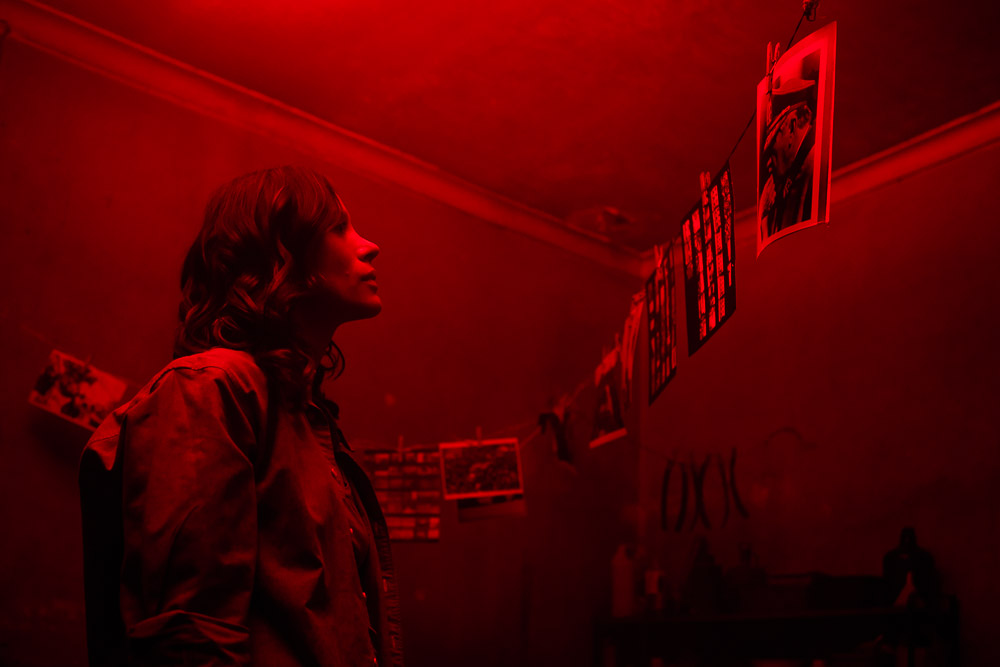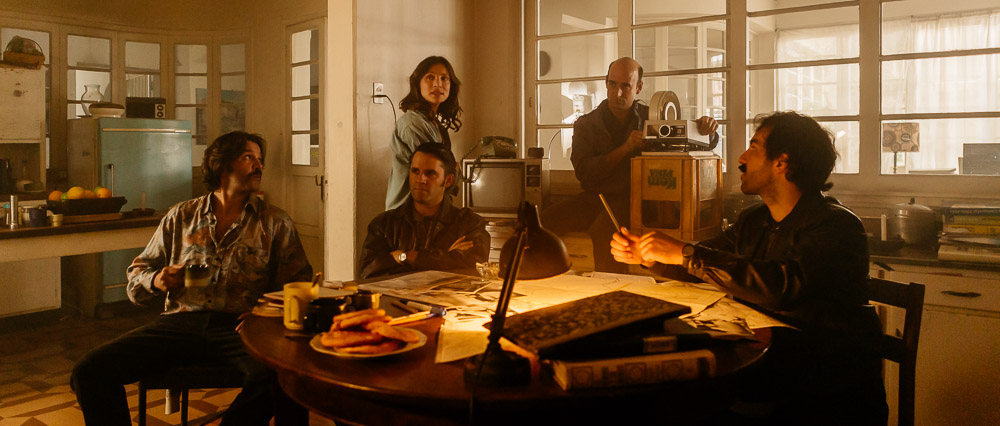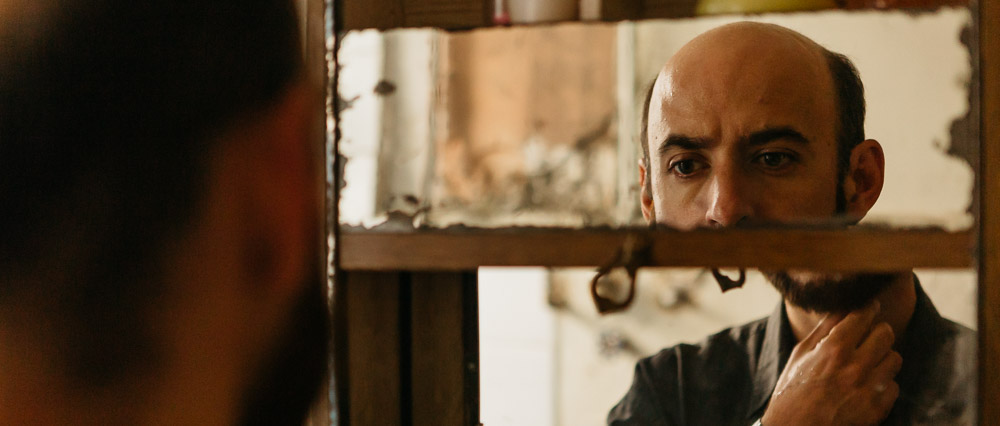
Inspiré de la tentative d’assassinat du dictateur chilien en 1986, le film raconte l’histoire de plusieurs membres du Front Patriotique Manuel Rodríguez et la façon dont ils auraient monté l’opération, rassemblant une vingtaine de combattants de ce bras armé du Parti communiste chilien. Pour le spectateur, pas de surprise, on sait que Pinochet a survécu à l’attaque, même s’il s’en est fallu de peu.
Envisagé dans un tout premier temps sous une forme documentaire, il s’agit du premier long-métrage de fiction de Juan Ignacio Sabatini. Il y a quelques années, le vent de révolte qui soufflait dans son pays a poussé Juan a vouloir raconter cette histoire, mais la pespective de devoir réaliser un documentaire avec peu de documents d’époque filmés et peu d’acteurs encore en vie l’a convaincu d’imaginer plutôt un récit de fiction.
La construction narrative de « Matar a Pinochet » est à la fois simple et intrigante. Elle raconte les préparatifs, le déroulement de la tentative d’assassinat, ses conséquences (trahison, répression) et s’attache à la commandante Tamara, la jeune femme à la tête du commando, à Ramiro et Sacha, deux membres du groupe. Et alors que le récit progresse, se poursuit une discussion entre Ramiro et Tamara à bord d’une voiture qui roule vers on ne sait où, les deux personnages évoquant l’opération, leur implication mutuelle dans le groupe et finalement quels sont leurs situations personnelles respectives. Cet espace « trans narratif » en quelque sorte, est pourtant au cœur du dénouement de l’intrigue, qui ne s’envisage réellement qu’à son aboutissement. Bref, de la subtilité dans l’efficacité, et une mise en image très maîtrisée et sans ostentation.

Je me suis demandé durant toute la projection comment on produisait cette image qui me semblait si organique et si précise. Après avoir pensé à de la pellicule 35mm, j’ai eu la réponse : Alexa Mini et série Cooke anamorphique /i x2 (25-32-50-75-135). Et lumière naturelle majoritaire à quelques rare exceptions près. Cela n’en a que plus suscité mon intérêt d’en savoir un peu plus, en discutant avec Juan Ignacio Sabatini, réalisateur, et Enrique Stindt, directeur de la photographie.
Passer d’un projet de film documentaire à un long-métrage de fiction a de nombreuses implications. Que pouvait amener la fiction, en termes visuels ?
Juan : Le film est inspiré de faits réels, la tentative d’attentat contre Pinochet, mais c’est la fiction de long-métrage qui s’est imposée. J’ai toujours senti que l’histoire serait plus forte si nous prenions nos distances avec la réalité, y compris visuellement, et d’une certaine manière je pense que nous y sommes parvenus.
Qu’est-ce qui a présidé au choix de la caméra et des optiques?
Juan : Mon intention première était de tourner en 16mm avec des optiques sphériques, mais mon producteur s’y est vite opposé, essentiellement pour des questions de budget. Une fois revenu au numérique, nous avons choisi l’Alexa Mini sans hésitation puis Enrique a proposé de tourner le film avec des Cooke anamorphiques.
Étant donnée l’histoire que nous voulions raconter, j’ai adoré l’idée que les personnages puissent être à la même valeur de plan dans ce grand cadre horizontal, chacun se trouvant parfois aux extrémités, dans la zone d’aberration, qui est aussi une zone d’incertitude ou tout peut arriver.
Je n’avais jamais eu l’occasion de tourner en anamorphique auparavant, et cela m’a énormément plu.
Enrique : En termes de caméra, je pense que l’Alexa Mini était un choix évident pour un long-métrage. Je sais ce que peut me donner le capteur, notamment en termes de sous exposition, et je me sentais en confiance. L’idée de tourner en anamorphique est venue en partie de la densité très cinématographique offerte par les optiques, mais aussi parce que cela induisait le fait de se positionner le plus loin possible du documentaire.
Le véritable défi était de prendre le parti de la fiction vis-à-vis d’une histoire réelle et si sensible pour le peuple chilien.

Comment avez-vous préparé le tournage ? Comment avez-vous choisi les décors ? Avez-vous travaillé avec un storyboard ?
Juan: Nous avons pris le temps en pré-production de discuter chaque scène du scénario, en quoi chacune faisait sens dans l’histoire. Puis nous avons établi une première approche sur notre façon de les tourner.
Concernant les décors, ce n’était pas évident de filmer une histoire qui se passe à la fin des années 80 à Santiago, car malheureusement nous vivons dans un pays qui n’a pas conscience de l’histoire de son architecture. En conséquence, depuis une vingtaine d’années une bonne partie de la ville a été détruite et remplacée par de grands immeubles et des autoroutes, et ce qui restait a disparu dans deux tremblements de terre en 1985 et en 2010. Nous avons alors eu la bonne idée de tourner à Valparaiso, le principal port du pays à seulement une heure de demi de Santiago, qui nous offrait tous les lieux de tournage que nous recherchions.
La seule séquence que nous avons storyboardée est celle de la tentative d’assassinat. Je ne suis pas très fan du storyboard, j’ai l’impression que cela rend les choses un peu trop schématiques.
Juan, toi qui viens du documentaire, comment as-tu rencontré Enrique et qu’est-ce qui t’as incité à travailler avec lui ?
Juan: J’ai toujours apprécié le travail d’Enrique. Il n’est pas seulement directeur de la photographie, c’est un artiste aux multiples talents, doué d’une sensibilité extraordinaire pour comprendre ce que nous fabriquons, et avec laquelle je suis en phase à diverses égards. « Matar a Pinochet » était le bon projet pour entamer notre collaboration, il a su traduire en images ce à quoi j’ai rêvé durant plusieurs années de ma vie.
Enrique, qu’est-ce qui t’as intéressé dans le projet de Juan ?
Enrique : Tout d’abord, j’admire l’énergie et la conviction avec laquelle Juan défend ses projets. La motivation du réalisateur est très importante pour moi quel que soit le projet. Ce qui m’a intéressé dans ce projet ci, c’est le véritable défi de raconter cette histoire complexe mais si réaliste.

Quelle a été ton approche de la mise en lumière, avec quel matériel as-tu travaillé ?
Enrique: Nous avons décidé que la mise en scène et en image devait être simple et sans chichis, pour ne pas tomber dans une forme trop esthétisante ou trop démonstrative.
J’ai donc décidé de travailler avec une petite liste lumière, agrémentée de sources in situ. La base devait être la lumière naturelle et disponible au moment du tournage. J’ai utilisé des boules chinoises maison, un HMI 1.8KW corrigé pour obtenir une teinte plus chaleureuse, 3 Skypanel S60 et 2 sources sodium portables pour les effets de réverbères. Une toute petite liste lumière donc, et beaucoup de toiles, de drapeaux, de diffusions.
À propos des teintes du film, est-ce que tu as travaillé avec des LUT spécifiques étudiées en prépa ? Comment as-tu abordé l’étalonnage du film ?
Enrique : J’ai basiquement travaillé avec une LUT Alexa 709, et opéré des variations en ISO et en température de couleurs. Par la suite j’ai ajouté du grain en étalonnage pour approcher du rendu de la pellicule et contrer l’aspect très propre du numérique. J’en ai profité pour amener des différences subtiles entre le passé et le présent au sein du récit. Plus de grain dans le passé, moins dans le présent, un peu plus de chaleur dans le passé, un cyan tempéré dans le présent.
Il y a dans le film une balance subtile entre les scènes de groupe et les scènes plus intimes avec un ou deux personnages. J’ai eu la sensation que la caméra se trouvait à une distance qui permet au spectateur d’être toujours proche des personnages. Comment as-tu envisagé la façon de filmer les personnages principaux de l’intrigue : Tamara, Ramiro, Sacha ?
Enrique : Je pense que la proximité de la caméra avec les personnages doit permettre une empathie mais en même temps révéler leurs doutes et leurs contradictions. Je pense que cette proximité a fait ressortir la tension portée par chacun des personnages, filmés généralement au 50mm (ou la focale approchante).
Le film a été sélectionné aux festivals de Huelva et de la Havane, on peut le visionner sur la plateforme MUBI.
Plus d’images ici avec le trailer de « Matar a Pinochet ».
____
ENGLISH VERSION
____
Inspired by the attempt of assassination of the Chilean dictator in 1986, the movie tells the story of several members of the Manuel Rodríguez Patriotic Front and how they set up the operation, which gathered twenty members of this armed wing of the Chilean Communist Party. Audience won’t be surprised to know that Pinochet survived the attempt, even if he suffered slight injuries.
First envisioned as a documentary, it eventually became the first feature film of director Juan Ignacio Sabatini. A few years ago, the country encountered a time of revolt, that pushed Juan to tell this story, but the idea of making a documentary movie with too few filmed documents and too few actors still alive convinced him to dive into a fictional story.
The narrative construction of « Matar a Pinochet » is both simple and intriguing. It describes the preparation, the assassination attempt, its consequences (betrayal and repression), and focuses on Commander Tamara, the young woman in charge of the commando, to Ramiro and Sacha, two members of the group. As the story progresses, we’re on board of a car driving to who knows where with Ramiro and Tamara, the two discussing the operation, their mutual involvement in the group and the course of their own personal lives. This « trans narrative » space in a way, is nevertheless at the heart of the outcome of the plot, which is only really considered at its conclusion. Briefly said, there’s something subtle in this efficient story-telling, as well as a very controlled image that doesn’t show off.

During the screening I was wondering how this organic but yet precise look was done. I first thought of 35mm film stock, but here its the answer: Alexa Mini and Cooke Anamorphic/i 2x (25-32-50-75-135). And mostly natural light except on few setups. This sparked my interest in learning more about the movie, chatting with Juan Ignacio Sabatini, director, and Enrique Stindt, cinematographer.
Moving from a documentary project to a feature project has a lot of involvements, what did you think the visual work on a fiction could bring to the story?
Juan : This is a project based on real facts that rose in my head as a fiction feature film. I always thought that this story would become more powerful if we thought about an atmosphere far away from reality.
And in many ways I think we made it.
What guided you when it came to choose the camera and lens combo for the movie ?
Juan : My first intention was to shoot in 16mm with spherical lenses. Quickly my producer refused to follow that path basically for budget considerations. So when we came back to digital cinema, we had no doubt in choosing Alexa Mini, then Enrique came with the idea to shoot the film with Cook anamorphic lenses.
I really loved the idea to put the characters in a horizontal perspective where everybody had the same value (size ?) and had a chance to get to the aberration zones, that is as a way to view them going through different kinds of challenges.
Until then, I never had the chance to shoot with anamorphic lenses and I really enjoyed the trip.
Enrique : In terms of camera, i think Alexa mini is a kind of standard choice for feature films and I know about the sensor answer, so i feel confident with it, especially in terms of low light answer. We decided to work with anamorphic lenses because of the density of image (more cinematic) but mostly to enhance this project as a fiction film, far from a documentary one. It was a real challenge to elaborate a fiction about a real situation, that is still a so sensitive theme for Chilean people. I think the Cookes gave us the necessary contrast and warm tone I was looking for.

How did you prepare the shooting? How did you choose the locations? Did you use a storyboard ?
Juan: We took the time in pre-production to discuss every single scene from the script, pursuing the spirit and the meaning of each one of them, and then we designed a first idea of how to shoot them.
About the locations, it’s not easy to shoot a story that takes place in the late ’80s in Santiago because unfortunately we live in a country with a lack of conscience about its architecture’s history. That means that in the last 20 years a great percentage of the city was destroyed to build big buildings and highways, and the rest disappeared with two big earthquakes (1985 and 2010). So we had the great idea to shoot in Valparaiso, the main port of the country that is just an hour and a half from Santiago, where we found the appropriate locations for the script.
Regarding the storyboard, the only sequence that we drew was the attempt. I’m not a big fan of drawing things because I consider that in a way things become a little bit schematic.
Juan, since you come from the documentary world, how did you meet with Enrique and what convinced you to work with him ?
Juan : I always admired the work of Enrique. He is not just a DoP, he is a multifaceted artist with an extraordinary sensibility to understand what we are doing in this world, that in many ways I agree with. I found the perfect ‘alter ego’ to deliver in real images what I dreamt for a few years of my life.
Kill Pinochet was the perfect chance to collaborate together for the first time.
Enrique, what sparked your interest in Juan’s project ?
Enrique : First, I admire the energy and conviction of Juan to face the projects. That is very important for me in every work. Then, the challenge about telling a complex real history.

What was the overall approach on lighting, and what was your light package ?
Enrique : We decided to make a raw and simple staging, in a way to avoid an epic treatment or a hip esthetic mood. So I decided to work with a small package supplemented with practical lights, all based on natural and available light. I worked with custom chinese lamps, 1.8 HMI with quarte 85 gel and 3 S60 Skypanels, plus 2 real sodium street light portable. And a lot of nets, french flags and soft diffusion.
Talking about color, did you work with some specific LUT cooked ahead of the shoot? What got you to the final grade of the film ?
Enrique : I worked with ALEXA 709 lut , and made some variations in colour temperature and ISO. When in colour grading I put some grain layers to fight against the digital definition and push toward a film look. In this way, I made some subtle differences between the present and the past, grainier in the past and less for present time. Also warm mood in the past and quiet cyan for present.
There’s a subtle balance in the movie between the group scenes and the more intimate scenes with one or two characters, I felt the camera is always at the proper distance so the audience is close to the characters anyway. What were your considerations when it comes to portraying characters, Tamara, Ramiro and Sacha for instance ?
Enrique: I think that the closeness to the characters should be just and necessary in order to empathize with them but at the same time feel their contradictions and doubts. I feel that with this idea in mind, we managed to enhance the necessary tension that the actors should transmit. Mostly using 50mm lens or close to it.
The movie has been selected at Huelva and Havana festivals, and is also available on MUBI.
More images with « Matar a Pinochet » ‘s trailer.
-
Partager l'article


